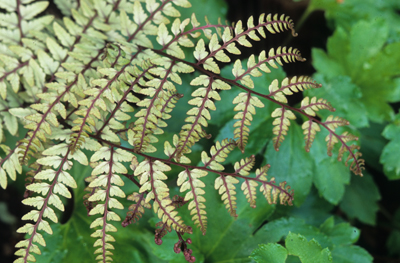|
Hardy Fern Home A. otophorum resources
All Ferns � Woodsiaceae �� Athyrium
�Other Genera
|
| Athyrium otophorum | ||
Eared lady fern | ||
|
Etymology
From oto, ear. See description of the pinnae.
Description
Rhizome: erect, short, scales linear-lanceolate, 0.8--1 cm long, black or blackish brown, polished.
Frond: 80 cm high by 30 cm wide, deciduous, monomorphic, blade/stipe ratio: 1:1 to 3:2. Stipe: burgundy, the color carried to rachis and costa, dark brown at swollen, laterally spinous base, old stipe bases persistent, scaly at base, 8-10 mm long, nearly black, lustrous, vascular bundles: 2, lunate, uniting to a U-shape above. Blade: 2-pinnate, triangular, papery, glabrous. Pinnae: 8 to 15 pair, nearly sessile, lanceolate, 2--4 cm broad, long-pointed at apex; pinnules eared outward at the base; costae with prominent spines on the upper side at costule-base ; margins serrate; veins free, forked, prominent on the lower surface. Sori: elongate to gently curved, near the costule, indusium: shape as for the sori. Culture
Habitat: no report found.
Distribution: Japan, Korea, China.
Hardy to -30�C, USDA Zone 4.
Distinctive Characteristics
the burgundy rachis and costa provide immediate recognition
Synonyms
Asplenium otophorum Miq. Diplazium otophorum (Miq.) C. Chr. Athyrium rigescens Makino |
|
|
